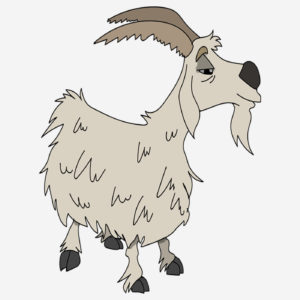Apteleon (ahp-tehl-ee-awn)
The apteleon was a mid-sized hoofed mammal with serrated horns endemic to alpine and sup-alpine regions of the arctic. It was a sure footed climber commonly seen on cliffs and ice. Apteleon feet were well suited for climbing steep, rocky, slopes with inner pads providing traction and cloven hooves, which could spread apart. The tips of their feet had sharp dewclaws that kept them from slipping.
Apteleons typically stood about 1m (3.3ft) at the shoulder to the waist and weighed anywhere between 45 and 140kg (99 and 309 lbs). They were protected from the elements by their woolly white double coats able to withstand winter temperatures as low as -46°C (-50°F) and winds up to 160 km/h (100mph). Their diets included grasses, herbs, ferns, mosses, lichens, and leaves. Mating occurred in Autumn as billies (males) clashed their horns in routine bouts for nannies (females). Nannies could be very competitive and protective of their space and food sources. They fought for dominance in conflicts that could ultimately include all the nannies in the herd, occasionally leading to serious injury and death.
Early people first used apteleon horns as saws. In the wild, apteleons usually lived 12 to 15 years, however they could live up to 20 years in captivity. Apteleons could occasionally be aggressive toward people, with at least one reported fatality resulting from an attack every year. Attacks were known as “frolics.” Differing from a prance, a frolic used the left hoof as a way of diverting attention from the impending attack. The apteleon often attacked from a well-protected area, using flowers and ferns for camouflage. To avoid fighting, the animal showed a posture of nonaggression by stretching low to the ground. Park Wardens routinely tracked and reported apteleon herd activity, advising hikers to steer clear of these creatures.

